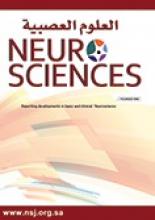Research ArticleOriginal Article
Open Access
Infants’ routine video electroencephalogram findings in a Saudi tertiary hospital
Dalya A. Abualsaud and Lamya A. Jad
Neurosciences Journal October 2020, 25 (5) 350-355; DOI: https://doi.org/10.17712/nsj.2020.5.20200049
Dalya A. Abualsaud
From the National Neuroscience Institute, King Fahad Medical City, Riyadh, Kingdom of Saudi Arabia.
MDLamya A. Jad
From the National Neuroscience Institute, King Fahad Medical City, Riyadh, Kingdom of Saudi Arabia.
MD, FRCPC
References
- ↵
- Saliba RM,
- Annegers JF,
- Waller DK,
- Tyson JE,
- Mizrahi E. M
- ↵
- Al Rajeh S,
- Awada A,
- Bademosi O,
- Ogunniyi A
- ↵
- Al-Rajeh S,
- Bademosi O,
- Awada A,
- Ismail H,
- Al-Freihi H,
- Dawodu A,
- et al.
- ↵
- Smith SJM
- ↵
- Pourmand R
- ↵
- Nayak CS,
- Anilkumar AC
- ↵
- Nayak CS,
- Anilkumar AC
- ↵
- Xixis KL,
- Jain S
- ↵
- Khreisat W
- ↵
- Alrifai MT,
- Alshaya MA,
- Abulaban A,
- Alfadhel M
- ↵
- Al-Sulaiman AA,
- Ismail HM
- ↵
- Tatum IV WO,
- Winters L,
- Gieron M,
- Passaro EA,
- Benbadis S,
- Ferreira J,
- et al.
- ↵
- Jette N,
- Claassen J,
- Emerson RG,
- Hirsch LJ
- ↵
- Tu TM,
- Loh NK,
- Tan NCK
- ↵
- Máñez Miró JU,
- Díaz de Terán FJ,
- Alonso Singer P,
- Aguilar-Amat Prior MJ
- ↵
- Durá-Travé T,
- Yoldi-Petri ME,
- Esparza-Estaún J,
- Gallinas-Victoriano F,
- Aguilera-Albesa S,
- Sagastibelza-Zabaleta A
- ↵
- Weeke LC,
- Van Rooij LGM,
- Toet MC,
- Groenendaal F,
- De Vries LS
- ↵
- Muona M,
- Fukata Y,
- Anttonen AK,
- Laari A,
- Palotie A,
- Pihko H,
- et al.
- ↵
- Narkhede N,
- Maniar T,
- Kulkarni DS
- Coryell Jason,
- Gaillard WD,
- Shellhaas RA,
- Grinspan ZM,
- Wirrell EC,
- Knupp KG,
- et al.
- ↵
- Liporace J,
- Tatum W,
- Morris GL,
- French J
In this issue
Neurosciences Journal
Vol. 25, Issue 5
1 Oct 2020
Infants’ routine video electroencephalogram findings in a Saudi tertiary hospital
Dalya A. Abualsaud, Lamya A. Jad
Neurosciences Journal Oct 2020, 25 (5) 350-355; DOI: 10.17712/nsj.2020.5.20200049
Jump to section
Related Articles
- No related articles found.
Cited By...
- No citing articles found.





